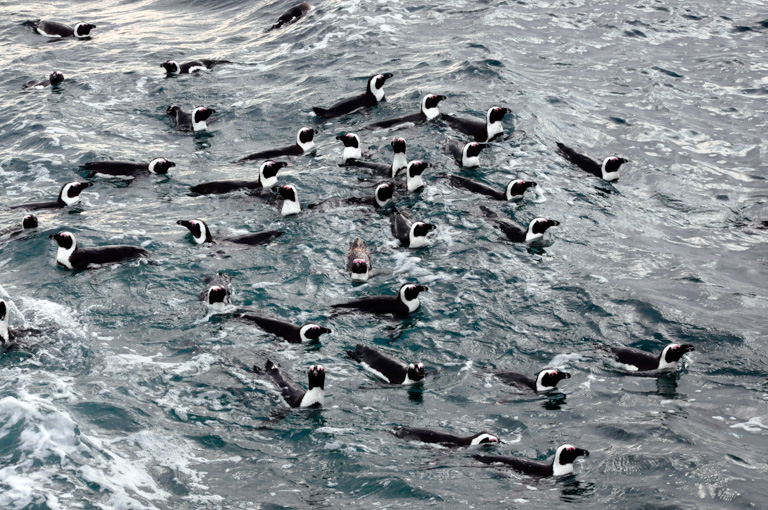- A recent closure of commercial fishing around South Africa’s Robben Island gave scientists the chance to understand how fluctuations in prey fish populations affect endangered African penguins (Spheniscus demersus) absent pressure from humans.
- The researchers found that the more fish were available, the better the condition of the penguin chicks that rely on their parents for food.
- This link between prey abundance in the sea and the condition of penguin chicks on land could serve as an indicator of changes in the ecosystem.
It’s hard to imagine how the oceans might operate without the sway of human activity. The recent assessment by the U.N. Intergovernmental Science-Policy Platform on Biodiversity and Ecosystem Services found that we’ve impacted 66 percent of the ocean in some way. Industrial-scale fishing, for example, can make it difficult for ecologists to understand the natural relationships that underpin predator-prey relationships unperturbed by human influence.
But a recent experimental shutdown of commercial fishing around South Africa’s Robben Island has given scientists a unique window into the details of one such relationship, demonstrating the impact that the availability of prey fish has on the behavior and health of endangered African penguins (Spheniscus demersus) absent pressure from humans.

“Understanding how African penguins forage to feed their chicks in their variable marine environment can help us identify conservation measures for these endangered populations,” Kate Campbell, an ecologist at the University of Cape Town and the leader of the research, said in a statement. “A three-year commercial fisheries closure around Robben Island created a unique opportunity to study how African penguins directly respond to natural changes in local abundance of their prey — anchovies and sardines.”
Campbell and her colleagues found that the more fish were available, the better the condition of the penguin chicks that rely on their parents for food. Outside of those times of plenty, penguins started to change their behavior, said University of Exeter ecologist Richard Sherley in the statement.
“Once food gets harder to find, more individuals will start to struggle and work harder, but they will do so at different rates, increasing the variation we see in foraging effort,” said Sherley, who was also a co-author of the paper.

The research, demonstrating that the abundance of sardines and anchovies accounted for about 60 percent of this variation, was published May 21 in the Journal of Applied Ecology.
Between 2011 and 2013, 75 parenting penguins fitted with GPS trackers recording the length and depth of their dives provided the team with information on the birds’ hunting strategies. They matched those results with data from a set of “hydro-acoustic surveys” within 20 kilometers (12 miles) of Robben Island over the same time period. This approach involved using an echo sounder to launch sound waves into the water. The way in which the waves bounced back allowed the researchers to estimate the abundance of sardines and anchovies.
The team also logged the diets of 83 penguins and measured the weights of 569 chicks.

Perhaps unsurprisingly, the chicks didn’t do as well when fish weren’t as numerous. The GPS-tracker data showed that their parents had to work harder and travel farther in search of prey during these periods. But those changes affected individual penguins in different ways.
“While some ‘superstar’ penguins find food easily, others are less successful,” Sherley said.
As the fish abundance declined, the scientists observed a wider variety of tactics, possibly caused by different approaches needed to catch prey that were more spread out or because they were going after a range of fish species — instead of the anchovies and sardines that typically sustain penguins — requiring a different set of maneuvers to capture.

This link between prey abundance in the sea and the condition of penguin chicks on land could serve as an indicator of changes in the ecosystem, the authors write, potentially helping fisheries managers take seabirds and their nutritional requirements into account in decision-making.
“Since these short-term changes will likely have knock-on effects for chick survival and penguin population size, they could be used as powerful early warning signs to inform fisheries’ policies and marine conservation efforts,” Campbell said. “Hopefully, in the future, we could aim to effectively balance fishery management with penguins’ needs, to reduce the impact on local economies whilst maximising the benefits to our oceans.”
Banner image of an adult African penguin by R.B. Sherley.
Citations
BirdLife International. (2018). Spheniscus demersus. The IUCN Red List of Threatened Species 2018: e.T22697810A132604504. http://dx.doi.org/10.2305/IUCN.UK.2018-2.RLTS.T22697810A132604504.en. Downloaded on 22 May 2019.
Campbell, K. J., Steinfurth, A., Underhill, L. G., Coetzee, J. C., Dyer, B. M., Ludynia, K., … Sherley, R. B. (2019). Local forage fish abundance influences foraging effort and offspring condition in an endangered marine predator. Journal of Applied Ecology. doi:10.1111/1365-2664.13409
FEEDBACK: Use this form to send a message to the author of this post. If you want to post a public comment, you can do that at the bottom of the page.
